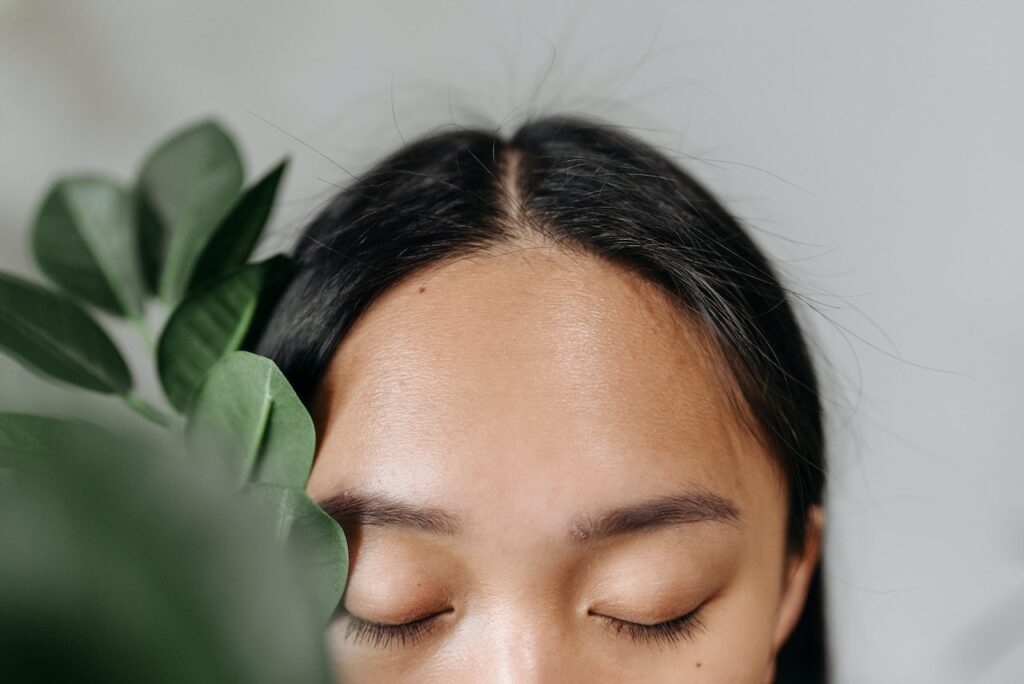Glabellar lines, also known as frown lines, are the vertical wrinkles that appear between the eyebrows. These lines are a common sign of aging and can make a person look older than they actually are. Glabellar lines are caused by repeated facial expressions, such as frowning or squinting, which can cause the skin to lose elasticity and form wrinkles.
Understanding glabellar lines is important for those who wish to prevent or treat them. While these lines are a natural part of the aging process, there are steps that can be taken to minimize their appearance. This article will explore the causes, symptoms, prevention, and treatment options for glabellar lines, as well as the risks and side effects associated with these treatments.
Key Takeaways
- Glabellar lines are vertical wrinkles that appear between the eyebrows and are caused by repeated facial expressions.
- Understanding the causes, symptoms, prevention, and treatment options for glabellar lines is important for those who wish to minimize their appearance.
- Treatment options for glabellar lines come with risks and side effects that should be carefully considered before undergoing any procedures.
Understanding Glabellar Lines
Glabellar lines, also known as frown lines, are the vertical lines that appear between the eyebrows when a person frowns or squints. These lines can make a person look older, tired, or angry, even when they are not.
Glabellar lines are caused by the repeated contraction of the muscles between the eyebrows, which can be due to various reasons such as stress, genetics, and aging. As the skin loses elasticity with age, these lines become more prominent and can deepen over time.
There are several treatment options available for glabellar lines, including injectable neurotoxins such as Botox and Dysport, dermal fillers, and laser treatments. Injectable neurotoxins work by temporarily relaxing the muscles that cause the lines, while dermal fillers can be used to fill in the lines and provide a smoother appearance. Laser treatments can also be used to stimulate collagen production and improve the skin’s texture.
It’s important to note that while these treatments can be effective, they are not permanent solutions and will require maintenance over time. Additionally, it’s essential to choose a qualified and experienced provider for any cosmetic treatment to ensure the best possible results and minimize the risk of complications.
Overall, understanding glabellar lines and the available treatment options can help individuals make informed decisions about their cosmetic goals and achieve a more youthful and refreshed appearance.
Causes of Glabellar Lines
Aging
Glabellar lines, also known as frown lines, are one of the most common signs of aging. As people age, their skin loses elasticity and collagen, which are essential components for maintaining smooth skin. This results in the formation of wrinkles, including glabellar lines. Additionally, the muscles that control facial expressions weaken, causing the skin to fold and crease.
Facial Expressions
Facial expressions play a significant role in the formation of glabellar lines. Repeatedly contracting the muscles between the eyebrows, such as when frowning or squinting, can cause the skin to crease and form wrinkles over time. People who frequently make these facial expressions are more likely to develop glabellar lines at a younger age.
Sun Exposure
Excessive sun exposure can also contribute to the development of glabellar lines. Ultraviolet (UV) rays from the sun can damage the skin’s collagen and elastin fibers, leading to the formation of wrinkles. Wearing sunscreen and avoiding prolonged sun exposure can help prevent the formation of glabellar lines caused by sun damage.
Smoking
Smoking is another significant contributor to the development of glabellar lines. Smoking causes the skin to age prematurely by reducing blood flow and oxygen to the skin. This can result in the formation of wrinkles, including glabellar lines. Quitting smoking can help prevent the formation of glabellar lines and improve overall skin health.
In summary, glabellar lines are caused by a combination of factors, including aging, facial expressions, sun exposure, and smoking. Understanding the causes of glabellar lines can help people take steps to prevent their formation and maintain smooth, youthful-looking skin.
Symptoms of Glabellar Lines
Glabellar lines, also known as frown lines or “11” lines, are wrinkles that form between the eyebrows. These lines are a common sign of aging and can be caused by repeated facial expressions, sun damage, and genetics.
The symptoms of glabellar lines include:
- Vertical wrinkles between the eyebrows
- Deep creases that appear when frowning or squinting
- Skin that appears loose or saggy in the forehead area
- A tired or angry appearance, even when relaxed
Glabellar lines can also be accompanied by other signs of aging, such as crow’s feet and forehead wrinkles.
While glabellar lines are a natural part of aging, they can be a source of concern for some people. Many individuals seek cosmetic treatments to reduce the appearance of these wrinkles and achieve a more youthful look.
Overall, the symptoms of glabellar lines can vary in severity and appearance, but they are a common sign of aging that can be treated with various cosmetic procedures.
Prevention of Glabellar Lines
Glabellar lines, also known as frown lines or “11” lines, are the vertical wrinkles that appear between the eyebrows. These lines are a natural part of the aging process, but they can also be caused by repetitive facial expressions, sun damage, and smoking. While it is impossible to completely prevent glabellar lines, there are steps that can be taken to minimize their appearance.
Sun Protection
Exposure to the sun’s harmful UV rays can cause premature aging and damage to the skin, including the development of glabellar lines. It is important to protect the skin from the sun by wearing a broad-spectrum sunscreen with an SPF of at least 30, seeking shade during peak sun hours, and wearing protective clothing such as hats and sunglasses.
Facial Exercises
Facial exercises can help to strengthen the muscles in the face and reduce the appearance of glabellar lines. One simple exercise involves placing the fingertips on the forehead and applying gentle pressure while trying to raise the eyebrows. This exercise can be repeated several times a day to help tone the muscles in the forehead.
Botox Injections
Botox injections are a popular cosmetic treatment for glabellar lines. Botox works by temporarily paralyzing the muscles that cause the wrinkles to form. While Botox injections can be effective in reducing the appearance of glabellar lines, they are not a permanent solution and will need to be repeated every few months to maintain the results.
Skin Care
Proper skin care can help to prevent the development of glabellar lines. This includes using a gentle cleanser, moisturizing daily, and avoiding harsh products that can dry out the skin. It is also important to avoid smoking, as smoking can accelerate the aging process and contribute to the development of wrinkles.
By following these preventative measures, individuals can minimize the appearance of glabellar lines and maintain a youthful, vibrant appearance.
Treatment Options for Glabellar Lines
Topical Creams
Topical creams can be a non-invasive option for treating glabellar lines. These creams work by relaxing the muscles in the area, which can help to reduce the appearance of wrinkles. Some of the most common ingredients in topical creams for glabellar lines include retinol, hyaluronic acid, and peptides. It is important to note that while these creams can be effective, they may take several weeks or even months to produce visible results.
Botox Injections
Botox injections are a popular and effective treatment option for glabellar lines. Botox works by relaxing the muscles in the area, which can help to reduce the appearance of wrinkles. The effects of Botox typically last for several months, after which time the injections will need to be repeated. It is important to note that while Botox is generally considered safe, there are some potential side effects, including bruising, swelling, and muscle weakness.
Dermal Fillers
Dermal fillers are another option for treating glabellar lines. These fillers work by adding volume to the area, which can help to smooth out wrinkles. Some of the most commonly used dermal fillers for glabellar lines include hyaluronic acid and collagen. The effects of dermal fillers typically last for several months to a year, after which time the injections will need to be repeated. It is important to note that while dermal fillers are generally considered safe, there are some potential side effects, including bruising, swelling, and allergic reactions.
Laser Resurfacing
Laser resurfacing is a more invasive option for treating glabellar lines. This procedure involves using a laser to remove the top layers of skin in the area, which can help to stimulate the growth of new collagen. The effects of laser resurfacing can last for several years, after which time the procedure may need to be repeated. It is important to note that while laser resurfacing can be effective, it is also associated with some potential risks, including scarring, infection, and changes in skin color.
In summary, there are several treatment options available for glabellar lines, including topical creams, Botox injections, dermal fillers, and laser resurfacing. Each of these options has its own benefits and risks, and the best option will depend on the individual’s specific needs and preferences. It is important to consult with a qualified healthcare provider to determine the most appropriate treatment plan.
Risks and Side Effects of Treatments
While treatments for glabellar lines can be effective, they do come with risks and potential side effects. It is important for individuals to understand these risks before undergoing any treatment.
One of the most common treatments for glabellar lines is the use of botulinum toxin injections, such as Botox or Dysport. While generally safe, there are potential side effects such as bruising, swelling, and redness at the injection site. In rare cases, individuals may experience more serious side effects such as difficulty breathing or swallowing, muscle weakness, or vision changes. It is important for individuals to discuss these risks with their healthcare provider before undergoing treatment.
Another treatment option for glabellar lines is dermal fillers. These fillers are injected into the skin to help smooth out wrinkles and lines. While generally safe, there are potential side effects such as bruising, swelling, and redness at the injection site. In rare cases, individuals may experience more serious side effects such as infection, allergic reaction, or damage to the skin or underlying tissue.
It is important for individuals to choose a qualified and experienced healthcare provider when undergoing any treatment for glabellar lines. Additionally, individuals should disclose any medical conditions, medications, or allergies to their provider before undergoing treatment.
Overall, while treatments for glabellar lines can be effective, it is important for individuals to understand the potential risks and side effects before undergoing any treatment.
Post-Treatment Care
After receiving treatment for glabellar lines, it is important to follow proper post-treatment care to ensure the best possible results. The following are some general guidelines to follow:
Avoid Touching the Treated Area
For at least 24 hours after treatment, it is recommended to avoid touching the treated area. This includes rubbing, massaging, or applying pressure to the area. This can help prevent the spread of the botulinum toxin to unintended muscles.
Avoid Strenuous Exercise
For the first 24 hours after treatment, it is recommended to avoid strenuous exercise. This includes activities such as weightlifting, running, or any other high-intensity exercise. This can help prevent the botulinum toxin from spreading to unintended muscles.
Avoid Alcohol Consumption
For the first 24 hours after treatment, it is recommended to avoid alcohol consumption. This can help prevent the botulinum toxin from spreading to unintended muscles.
Use Sunscreen
It is recommended to use sunscreen on the treated area to protect it from the sun’s harmful rays. This can help prevent the breakdown of the botulinum toxin.
Follow-Up Appointments
It is important to attend any follow-up appointments with the healthcare provider to ensure that the treatment is working as expected. Additional treatments may be necessary to achieve the desired results.
Conclusion
Glabellar lines are a common cosmetic concern for many people. While they are a natural part of the aging process, they can be treated with a variety of methods.
Botox injections are one of the most popular and effective treatments for glabellar lines. They work by temporarily paralyzing the muscles responsible for the lines, resulting in a smoother appearance. While the effects are not permanent, they can last for several months before requiring another treatment.
Other treatments for glabellar lines include dermal fillers, chemical peels, and laser resurfacing. These treatments work by stimulating collagen production, reducing the appearance of fine lines and wrinkles.
It’s important to note that while these treatments can be effective, they do come with risks and potential side effects. It’s important to work with a qualified and experienced provider to ensure that you receive the best possible care.
Overall, glabellar lines are a common cosmetic concern, but there are many treatment options available. With the help of a qualified provider, you can achieve a smoother, more youthful appearance.
Frequently Asked Questions
What causes glabellar lines?
Glabellar lines, also known as frown lines or “11” lines, are caused by the repeated contraction of the muscles between the eyebrows. These contractions can be caused by a variety of factors, including genetics, aging, sun exposure, and facial expressions.
How effective is Botox for treating frown lines between the eyes?
Botox is a highly effective treatment for glabellar lines. It works by blocking the nerve signals that cause the muscles to contract, which in turn reduces the appearance of frown lines. Botox typically lasts for 3-4 months before additional treatments are needed.
What are some home remedies for reducing the appearance of glabellar lines?
While there are no home remedies that can completely eliminate glabellar lines, there are some things you can do to reduce their appearance. These include using sunscreen to protect your skin from sun damage, staying hydrated to keep your skin moisturized, and using a retinol cream to encourage collagen production.
What is the difference between Botox and filler for treating glabellar lines?
Botox and filler are two different types of treatments for glabellar lines. Botox works by relaxing the muscles that cause the lines, while filler works by filling in the lines themselves. Botox is typically used for mild to moderate lines, while filler is used for more severe lines.
Can glabellar lines be treated with surgery?
While surgery is an option for treating glabellar lines, it is typically not the first choice. Surgical options include brow lifts and forehead lifts, which can help to smooth out the skin and reduce the appearance of lines. However, these procedures are more invasive and carry more risks than non-surgical options like Botox and filler.
What is the cost of Botox treatment for glabellar lines?
The cost of Botox treatment for glabellar lines varies depending on a number of factors, including the location of the clinic, the experience of the injector, and the number of units of Botox needed. On average, Botox for glabellar lines costs between $300 and $500 per treatment.





